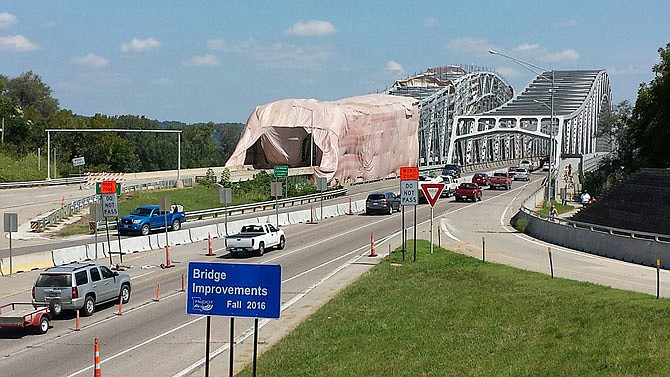In just 5 weeks, Jefferson City area motorists again should have two bridges crossing the Missouri River.
State Transportation officials announced Wednesday the now-closed westbound bridge is to be re-opened to traffic by 6 a.m. Nov. 14.
"We've worked with the contractor, and this is a date they are comfortable with completing the painting and priming and sandblasting of the bridge," Central District Engineer Dave Silvester said Wednesday afternoon.
The contractor - Saffo Inc., of Wilmington, North Carolina - has been sand-blasting old paint, replacing rusty rivets with bolts and then repainting the bridge, both over and under the driving surface.
"We will have a good, safe structure for another 20 to 30 years," Silvester said.
The bridge was erected in 1954 and was closed May 1 for the current project.
Since the westbound bridge closed, all traffic has been using the newest bridge, opened in 1991, that normally carries the eastbound traffic on U.S. 54 and 63.
The westbound bridge also was closed for six months in 1998 for another repainting project that included replacing the road deck.
Originally planned for 120 days, the bridge closing was extended in July because the contractor was finding more rivets to replace than originally expected.
Silvester said the current project is more complicated than the 1998 one.
"To redeck a bridge, it takes equipment and person-power," he said. "We can do a deck pretty quickly."
But the environmental regulations require the sandblasting and painting be done in an enclosed space, with all the materials used to be recovered, filtered and used again, Silvester said.
And the most complicated part was identifying between 6,000 and 7,000 worrisome rivets, then removing them and replacing them with heavy bolts.
Silvester said the bridge originally was erected only using rivets to hold the steel structure together - he didn't want to estimate how many thousands of rivets had been involved.
"Getting into the nooks and crannies of this bridge, replacing rivets with bolts, getting those rivets out and fixing the holes and putting the bolts in," he said, "is a time-consuming process.
"Basically, we're comparing apples and oranges when we talk about the redecking versus the type of work here."
Patty Lemongelli, MoDOT's Central District construction and materials engineer, said the painting project was slowed as more rivets were found that needed to be replaced.
That extra work required adjustments to the contract and an additional cost, raising the original price tag from $7 million to $7.5 million.
Saffo doesn't face penalties unless the westbound bridge isn't open by that 6 a.m. Nov. 14 deadline, she said.
MoDOT officials are "very pleased with the patience of the folks who travel the bridge daily," Silvester said, and are aware of consumer complaints it sometimes appeared as though nothing was being done.
However, he noted, the project involves both the bridge superstructure that motorists see easily and the bridge underneath the deck that's not visible to passers-by.
"Even after we announced the problem with the rivets (in July), we still had a 24/7 operation going," Silvester said. "But, as of late, we've gotten into some of the weather issues (where) you get down to some temperatures that aren't really conducive to painting, priming, so the hours have had to shift a little bit.
"We're still six days a week, as the hours allow us to work."
The last section to be sandblasted and painted crosses the Union Pacific Railroad tracks on the Cole County side of the river, and that work will be done only during the daytime because the railroad requires flaggers along the tracks to warn train traffic of the overhead work.
"It's time to get this done," Lemongelli said. "We've been out there longer than we'd anticipated - but I want everybody to know we have worked through this project quickly.
"It was on a very compressed timeline to begin with."
Once the westbound bridge is reopened, there still is some work to be done underneath the bridge, even as traffic moves overhead.
That work could cause some individual lane closures for short periods, she said.

